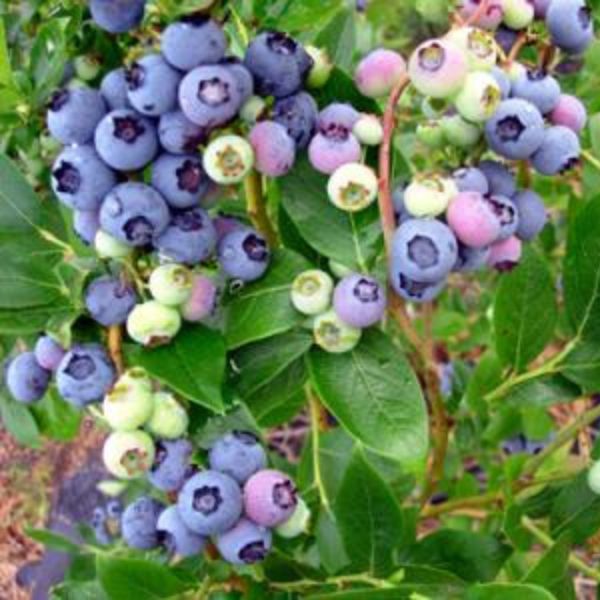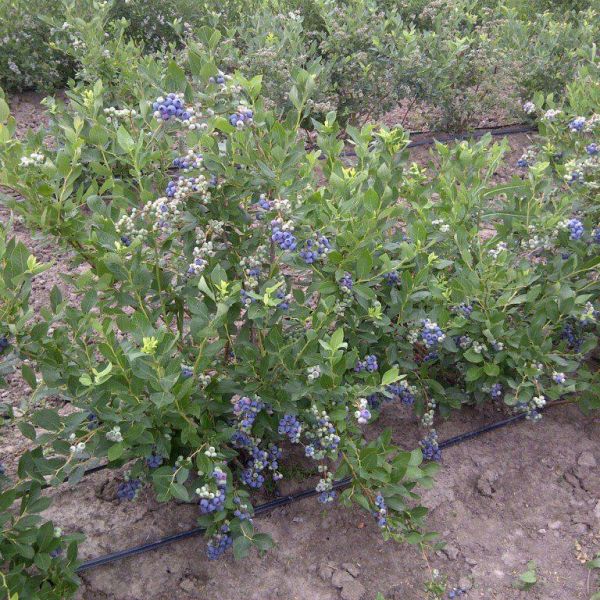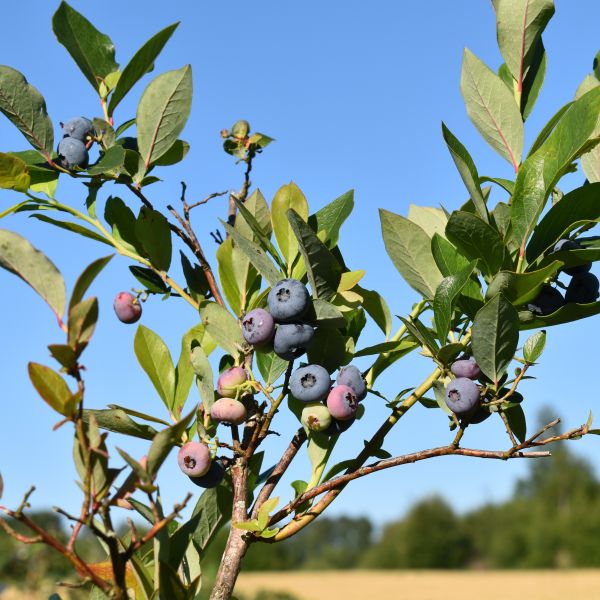




Duke Blueberry
Vaccinium corymbosum 'Duke'
99 reviews
Duke Blueberry
Vaccinium corymbosum 'Duke'
99 reviews
- Large, plump berries bursting with flavor
- High yielding, producing abundant fruit
- Cold-hardy and disease-resistant variety
- Recommended by landscape designers for optimal fit in real yards
$115.00
$165.00
30% Off
- Ships to in 3-5 Days
- Free Shipping Over $150
- Plant Arrival Guarantee
- In Stock
- Free Plant Consult
$200 - Landscape-Approved: Every Plant We Sell Comes With Design Expertise Behind It
2.5 Gallon
We are sorry, product is currently out of stock due to seasonal availability. Please check the "Related plants available in your area" section below
Not just beautiful - intentionally selected by ShrubHub's 3D landscape design team to fit real-world spaces and maximize yard potential.
Why Duke Blueberry?
Duke Blueberry, a cultivar of Vaccinium corymbosum, is popular for its numerous advantages. It is known for its high productivity, producing large quantities of plump, flavorful berries. Duke Blueberry bushes are also vigorous, adaptable to various climates and soil types. They are resistant to many diseases and pests, making them easier to maintain. Duke Blueberry is a great choice for gardeners seeking a reliable and fruitful blueberry variety.
Sunlight
Duke Blueberry plants require full sun exposure of at least 6-8 hours of direct sunlight per day to thrive and produce an abundant harvest of delicious blueberries.
Watering
Duke Blueberry plants require regular watering to keep the soil consistently moist, especially during the fruiting season. Adequate moisture is essential for the growth and development of the berries, ensuring they reach their full potential in size and fl
Fertilizing
The specific fertilizer requirement for Duke Blueberry is not specified in the given context. It is recommended to consult a horticulturist or refer to the specific recommendations provided by the producer or supplier for accurate information.
Duke Blueberry (Vaccinium corymbosum 'Duke')
The Duke Blueberry (Vaccinium corymbosum 'Duke') is a popular variety of highbush blueberry that is prized for its large and delicious berries. It is a deciduous shrub that typically grows to a height of 4 to 6 feet and has a spread of about 3 to 4 feet.
The Duke Blueberry features an upright habit with dense, dark green foliage that turns a vibrant red in the fall, adding ornamental value to your garden. It produces an abundance of medium-sized, powder blue berries that ripen in mid-season, usually around July or August.
The berries of the Duke Blueberry are known for their exceptional flavor and sweet-tart taste. They are perfect for eating fresh, baking into pies, making jams, or adding to your favorite smoothies. The berries are also highly nutritious, packed with antioxidants and vitamins.
This variety of blueberry plant is self-pollinating, but having another compatible blueberry variety nearby can increase fruit production. It prefers full sun exposure and well-drained, acidic soil with a pH range of 4.5 to 5.5. Duke Blueberry is also fairly tolerant of different soil types, making it suitable for various garden environments.
The Duke Blueberry is a relatively low-maintenance plant that requires regular watering, especially during periods of drought. It benefits from mulching to conserve moisture and suppress weeds. Pruning is recommended in late winter or early spring to remove damaged or overcrowded branches and to encourage new growth.
Whether you are a seasoned gardener or a blueberry enthusiast, the Duke Blueberry is an excellent choice for a productive and attractive blueberry shrub. With its delicious berries, beautiful foliage, and ease of care, this variety is sure to bring joy to your garden and kitchen.
Plant Information:
| Botanical Name: | Vaccinium corymbosum 'Duke' |
| USDA Zones: | 4 - 7 |
| Exposure: | Full Sun |
| Soil Needs: | Widely Adaptable |
| Mature Height: | 4 - 6 feet |
| Mature Spread: | 5 - 8 feet |





Pollination Info
Pollination Information for Duke Blueberry (Vaccinium corymbosum 'Duke')
The Duke Blueberry (Vaccinium corymbosum 'Duke') is a highbush blueberry variety that produces large, flavorful berries. Proper pollination is essential for good fruit set and optimal crop production. Here is some detailed information regarding the pollination requirements of Duke Blueberry:
1. Flower Structure
Duke Blueberry flowers are perfect, meaning they contain both male (stamens) and female (pistil) reproductive parts in the same flower. However, the anthers (part of the stamen that produces pollen) do not dehisce (open) at the same time as the stigma (part of the pistil that receives pollen). This temporal separation is known as a "protandrous" flowering pattern.
2. Self-Fertility
Duke Blueberry is partially self-fertile, which means it has the ability to set fruit from its own pollen to some extent. However, cross-pollination with another compatible blueberry variety often leads to higher yields and better fruit quality.
3. Cross-Pollination
To ensure good cross-pollination, it is advisable to plant another highbush variety near Duke Blueberry. This will provide an adequate supply of compatible pollen for effective fertilization. Some recommended cross-pollinators for Duke Blueberry include Bluecrop, Jersey, or Elliott. These varieties have overlapping flowering times with Duke and are compatible for pollination.
4. Pollinator Attraction
Blueberry flowers are typically pollinated by bees, primarily honeybees. Other native pollinators such as bumblebees and solitary bees may also contribute to the pollination process. To attract pollinators, it is important to provide a diverse landscape with flowering plants that bloom throughout the growing season.
5. Plant Spacing
When planting Duke Blueberry and its recommended cross-pollinator(s), ensure that the distance between them does not exceed 100 feet (30 meters). This proximity facilitates bee movement between the plants, enhancing effective cross-pollination.
6. Environmental Factors
Pollination success can be influenced by various environmental factors such as temperature, humidity, and weather conditions during the flowering period. Ideally, moderate temperatures (around 70°F or 21°C) with low wind speeds are favorable for bee activity and pollination.
By considering these pollination requirements and implementing appropriate practices, you can maximize the fruit yield and quality of your Duke Blueberry plants.
FAQ
Duke Blueberry (Vaccinium corymbosum 'Duke') FAQ
1. What is Duke Blueberry?
Duke Blueberry (Vaccinium corymbosum 'Duke') is a popular cultivar of highbush blueberry. It belongs to the Vaccinium genus and produces delicious, medium-sized blueberries.
2. How tall does Duke Blueberry grow?
Duke Blueberry typically grows to a height of around 4-6 feet (1.2-1.8 meters) when fully mature.
3. When does Duke Blueberry fruit?
Duke Blueberry usually starts to bear fruit in mid-summer, typically between June and July.
4. Are Duke Blueberries self-pollinating?
No, Duke Blueberries are not self-pollinating. They require cross-pollination with another compatible highbush blueberry variety, such as Bluecrop or Elliot, to produce a good crop of berries.
5. How do I care for Duke Blueberry?
- Plant Duke Blueberry in well-draining soil with a pH level between 4.5 and 5.5.
- Choose a sunny location for planting, as blueberries thrive in full sun.
- Ensure the soil is consistently moist but not waterlogged, especially during the fruiting season.
- Mulch around the base of the plant to retain moisture and control weeds.
- Prune the plant during the dormant season to maintain its shape and remove dead or weak branches.
- Fertilize Duke Blueberry with an acid-loving fertilizer in early spring.
6. How often should Duke Blueberry be watered?
Regular watering is essential for Duke Blueberry plants, especially during the growing season. Aim to keep the soil consistently moist, but avoid waterlogged conditions.
7. Can Duke Blueberry be grown in containers?
Yes, Duke Blueberry is suitable for container gardening. Choose a large container with good drainage holes and fill it with acidic potting soil. Make sure to provide regular water and proper sunlight for the plant to thrive.
8. When should I harvest Duke Blueberries?
Duke Blueberries are ripe for harvest when they turn dark blue and easily come off the plant with a slight twist. This usually occurs in mid to late summer.
9. Are Duke Blueberries prone to any pests or diseases?
Duke Blueberries may be susceptible to pests such as aphids, spider mites, and blueberry maggots. They can also be affected by diseases like powdery mildew and root rot. Proper care, regular inspection, and appropriate pest and disease management can help prevent and control these issues.
10. Can I eat Duke Blueberries straight from the plant?
Yes, Duke Blueberries are delicious and safe to eat right off the plant. They make a wonderful addition to fruit salads, smoothies, baked goods, and jams.
Planting & Care
Planting & Care for Duke Blueberry (Vaccinium corymbosum 'Duke')
Duke blueberry (Vaccinium corymbosum 'Duke') is a highbush variety known for its large, flavorful berries. Proper planting and care are essential for the healthy growth and fruit production of this blueberry cultivar. Here are some guidelines:
Planting:
- Choose a sunny location with well-drained soil. Blueberries prefer acidic soil with a pH between 4.5 and 5.5.
- Prepare the planting area by removing all weeds and grass. Dig a hole twice as wide and deep as the root ball of the plant.
- Mix organic matter like peat moss or compost into the soil to improve drainage and acidity.
- Place the blueberry plant in the hole, ensuring the crown is level with the soil surface. Fill the hole with soil, gently firming it around the roots.
- Water thoroughly after planting and apply a layer of mulch around the base of the plant to conserve moisture and prevent weed growth.
- Watering: Blueberries need consistent moisture, especially during dry periods. Water deeply once a week, providing about 1-2 inches of water.
- Fertilization: Apply a balanced fertilizer formulated for acid-loving plants in early spring before new growth begins. Follow the package instructions for the appropriate amount.
- Pruning: Prune in late winter or early spring to remove dead, damaged, or overcrowded branches. Pruning helps promote air circulation and facilitates berry production.
- Pest Control: Monitor for common pests like aphids, mites, or fruitworms. Use organic or chemical insecticides as necessary, following the instructions carefully.
- Netting: If birds are a problem, cover the bushes with bird netting once the berries start to ripen.
- Winter Protection: In colder climates, protect the plants from harsh winter conditions by covering them with burlap or a breathable fabric.
Care:
By following these planting and care instructions, you can ensure the successful growth and bountiful harvest of Duke blueberries. Enjoy the delicious fruits of your labor!
Check Out These Verified Customer Reviews:
Customer Reviews
4.6 out of 5 based on 99 reviews
Thank you! Your review has been submitted.
Fresh and juicy blueberries.
Delighted with the quality of the Duke Blueberries. Will definitely be ordering more.
High-quality, flavorful blueberries.
Item has been added to your cart.


